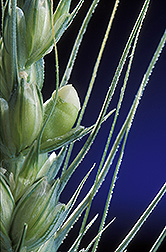This page has been archived and is being provided for reference purposes only. The page is no longer being updated, and therefore, links on the page may be invalid.
|
Understanding Rye and Rice May Help Farmers Improve Wheat
By Marty ClarkMarch 21, 2005
Nearly 40 percent of the world's arable land is too acidic to grow wheat, mainly because of high aluminum levels in the soil. But an Agricultural Research Service (ARS) geneticist hopes to make wheat more aluminum-tolerant by using a gene from rye, a cousin of wheat.
J. Perry Gustafson, at the ARS Plant Genetics Research Unit in Columbia, Mo., and cooperators discovered the Alt3 gene in rye several years ago. Alt3 makes rye tolerant to aluminum, which is usually found just below the topsoil. But then the researchers had to physically map the rye gene, so it can be transferred into wheat by marker-assisted selection and breeding.
To do that, the group turned to rice, because it is genetically similar to rye and wheat. Among these cereals, there is a high degree of genetic similarity--what scientists call synteny. A complete DNA sequence and gene map of rice has already been established. Since many of the genes in rye and rice are in the same order, finding exactly where the aluminum-tolerance candidate gene is in the rice genome may help researchers find its location in rye.
Gustafson's group was able to narrow the gene's location to a tiny region in rice, but it has not been able to utilize the rice DNA sequence to find the Alt3 gene in rye. The research, however, was not in vain. Gustafson found that rice is a great source of DNA markers that can be used to map the rye genome.
Rice has the possibility of being used to find many agronomically important genes in other cereals as well. Researchers may be able to use the rice DNA sequence information to identify genes in other cereals that can improve grain quality or naturally protect the crop against diseases.
The research has been published in the journal Theoretical and Applied Genetics.
ARS is the U.S. Department of Agriculture's chief scientific research agency.


